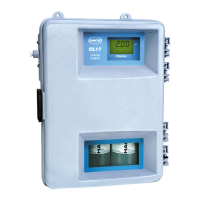Page 16
Installing the Sample Line
54400_install.fm
Section 1
1.5 Installing the Sample Line
Selecting a good, representative sampling point is important for optimum
performance of your instrument. The sample analyzed must be representative
of the condition of the entire system. Erratic readings will be seen if sample is
drawn from a location too close to points of chemical additions to the process
stream, if mixing is inadequate, or if the chemical reaction is incomplete.
If the sample pressure into the instrument exceeds 5 psig at the analyzer inlet,
flooding and instrument damage may result unless the sample conditioning kit
is installed.
Install sample line taps into the side or center of larger process pipes to
minimize the chance of ingesting sediment from the pipe line bottom or air
bubbles from the top. A tap projecting into the center of the pipe is ideal.
See Figure 5.
Figure 5 Sample Line Location in the Process Stream
1.6 Sample Conditioning
All samples are “conditioned” using the single-sample, basic sample
conditioning kit shipped with each analyzer. The kit eliminates large particles
using a 40-mesh strainer.
The ball valve on the raw sample inlet line may be used to control the amount
of bypass flow that is delivered to the filter. For dirty water, high bypass will
adjust it to help keep the strainer clean longer, or adjust it to any partially open
position for continuous bypass. Adjust the ball valve on the instrument supply
line to control the flow rate of filtered sample to the instrument.
Note: Installing the drain tee more
than 2 feet above the instrument can
result in excessive pressure which
may cause leaks.
Mount the centerline of the bypass drain tee two feet above the instrument,
see Figure 6. When properly mounted, the vacuum breaker design of the
bypass drain tee prevents negative sample pressure and establishes the
needed positive sample pressure for sample flow through the analyzer.
Poor
Sediment (Typical)
Air (Typical)
Poor
Good Best

